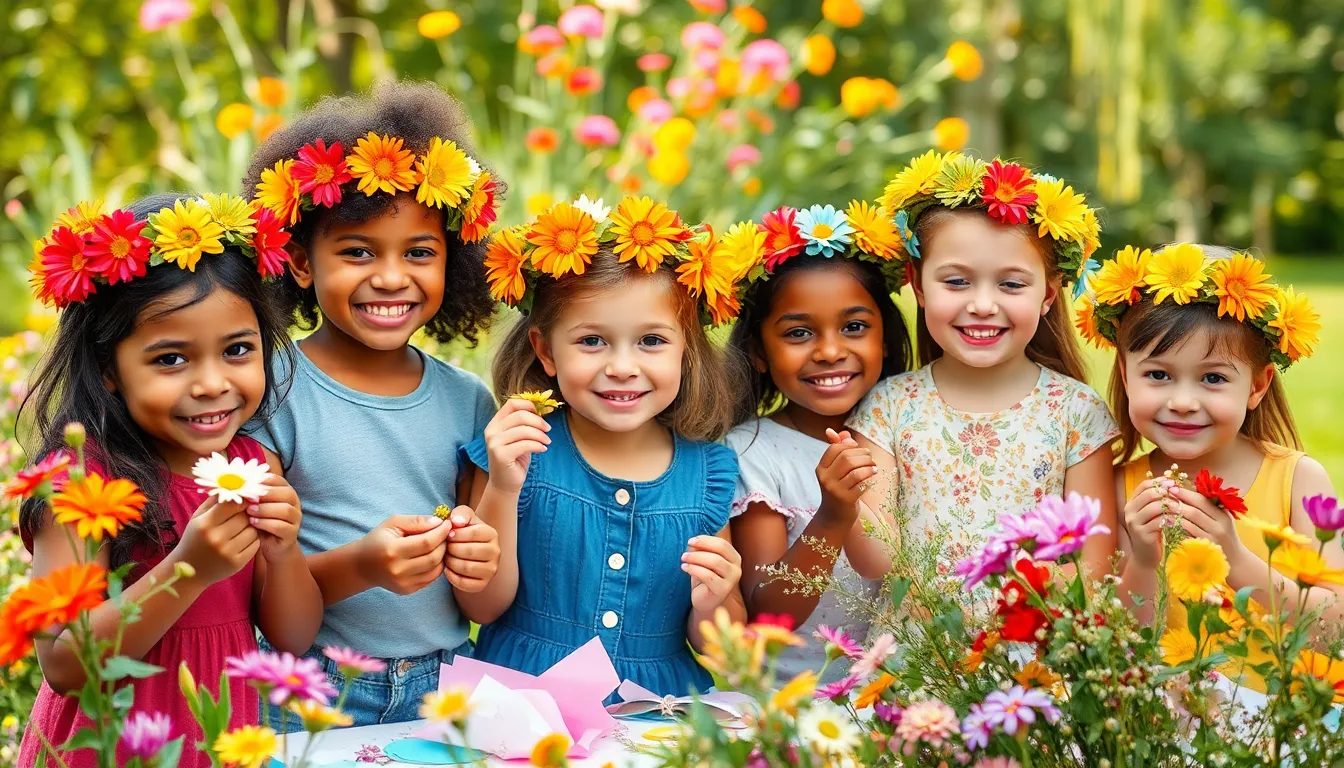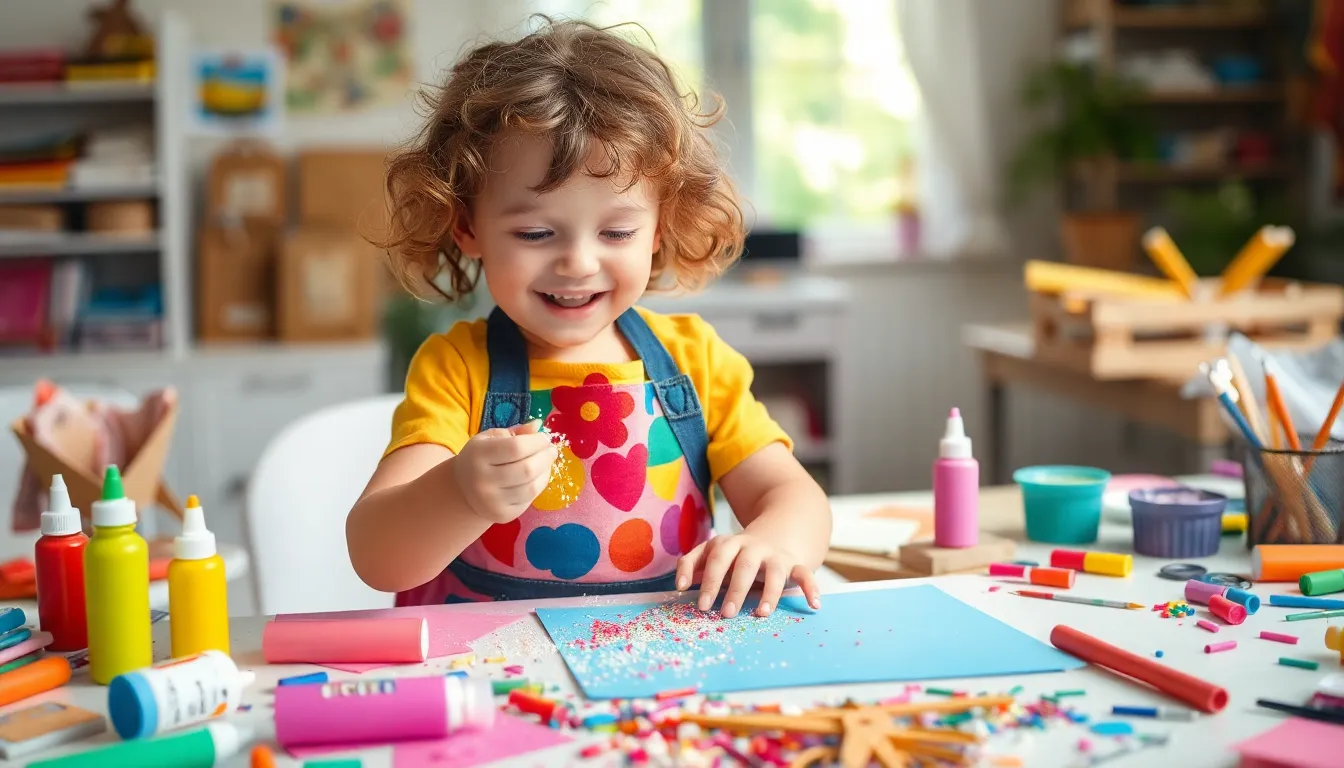Every parent knows that keeping kids entertained can sometimes feel like herding cats. But fear not! Children’s crafts are here to save the day, turning chaos into creativity. Imagine a world where glitter, glue, and a sprinkle of imagination transform a rainy afternoon into a masterpiece.
Table of Contents
ToggleBenefits of Children’s Crafts
Children’s crafts offer numerous advantages that contribute to their overall development. Engaging in these activities fosters personal growth and creativity.
Enhancing Creativity
Craft activities stimulate imaginative thinking. Children explore various materials like paper, paint, and clay, allowing them to express their artistic visions. With each project, kids gain the confidence to experiment with colors and shapes. They learn to view problems from multiple angles, fostering innovative solutions. Developing unique ideas becomes a natural outcome as they engage in hands-on activities. Plus, expressing themselves artistically enhances their self-esteem and emotional well-being.
Improving Motor Skills
Children’s crafts significantly boost fine motor skills. As they cut, glue, and assemble various components, hand-eye coordination improves. Manipulating small objects challenges dexterity and strengthens hand muscles. Engaging in these activities requires concentration, further enhancing focus. Kids learn to control their movements more precisely, benefiting future tasks like writing or drawing. These crafts provide a foundation for developing essential skills that support learning and everyday activities.
Popular Children’s Crafts

Children’s crafts encompass a variety of engaging activities that entertain while promoting creativity and skill development. Different craft themes allow for exploration across seasons and educational subjects.
Seasonal Crafts
Seasonal crafts offer engaging opportunities that align with various holidays and changes in nature. With spring, children can create flower crowns using paper and natural elements. Summer invites sand art projects utilizing colored sand, which encourages sensory exploration. During fall, crafting with leaves fosters a connection to the outdoors. Winter brings excitement with homemade ornaments for holiday decorations. Each project serves as a fun way for children to express their seasonal spirit while enhancing creativity and fine motor skills.
Educational Crafts
Educational crafts blend creativity with learning, making subjects more engaging. Map-making activities enable children to explore geography by experimenting with different materials. Science-themed crafts, such as building volcanoes, allow kids to witness chemical reactions hands-on. Language arts can be enriched through storytelling with puppets, providing a playful twist on narrative skills. Math skills improve with craft activities involving shapes and measurements. Each educational project encourages critical thinking while reinforcing essential academic concepts.
Materials for Children’s Crafts
Crafting requires a variety of materials that inspire creativity and help children express themselves. Choosing the right supplies enhances the crafting experience and fosters imaginative play.
Eco-Friendly Options
Recycled materials serve as excellent eco-friendly options for crafts. Items like cardboard boxes, paper towel rolls, and egg cartons can be transformed into unique creations. Natural materials also provide alternatives; leaves, stones, and twigs encourage exploration of the outdoors while promoting sustainability. Non-toxic paints and biodegradable glues contribute to a healthier crafting environment. Many craft stores now offer eco-conscious products, making it easier for parents to select sustainable supplies. By prioritizing these options, parents teach children about environmental responsibility while nurturing their artistic expressions.
Safety Considerations
Safety should be a top priority when selecting materials for children’s crafts. Non-toxic, child-safe supplies reduce health risks during creative activities. Parents should regularly check age recommendations on packaging to ensure materials suit their child’s developmental stage. Sharp scissors, in particular, require careful supervision; using safety scissors mitigates potential injuries. Small items, such as beads and buttons, pose choking hazards for younger children and must be managed appropriately. Keeping a clean workspace also helps minimize accidents and ensures an enjoyable crafting experience. Regular discussions about safety encourage children to be mindful and responsible while engaging in crafts.
Craft Ideas for Different Age Groups
Craft activities benefit children across various age ranges. Engaging in age-appropriate projects stimulates creativity and skill development.
Crafts for Toddlers
Toddlers thrive with simple crafts that foster sensory exploration. Finger painting provides a tactile experience, letting young children express themselves. Paper plate animals encourage imaginative play while enhancing fine motor skills. Collages made from colorful paper scraps allow toddlers to explore textures and colors. Additionally, crafting with safe materials like non-toxic glue ensures safety. Simple activities lay a foundation for creativity and confidence, encouraging toddlers to explore their imaginative potential.
Crafts for School-Aged Children
School-aged children enjoy more complex and varied craft projects. DIY jewelry using beads improves dexterity and inspires creativity. Model building with clay fosters critical thinking while allowing for artistic expression. Creating seasonal decorations helps children connect with nature and express their feelings about different times of the year. Educational crafts, like making a solar system model, blend fun with learning. These projects enhance knowledge in subjects like science and art by combining creativity with academic concepts. Crafting during this stage promotes social skills when children work collaboratively.
Tips for Successful Crafting Sessions
Crafting sessions thrive on organization and creativity. Parents can set the stage for success by following a few practical tips.
Organizing Supplies
Organizing supplies streamlines the crafting process. Designate a space for crafting where materials can be easily accessed. Gather items such as scissors, glue, paper, and colors into labeled bins. Clearly labeled containers enable quick retrieval and minimize distractions. Consider using transparent containers to help kids see their options at a glance. Having a variety of eco-friendly materials enhances the crafting experience while teaching sustainability. Ensure all supplies are safe and age-appropriate. With everything in its place, children can focus on their creative endeavors without interruptions.
Encouraging Imagination
Encouraging imagination sparks creativity in children. Providing them with open-ended projects allows for exploration and personal expression. Suggest themes but let children choose their colors and designs. Presenting options such as painted rocks or clay sculptures can inspire unique creations. Displaying their crafts prominently boosts confidence and motivates them to share their work. Creating a judgment-free environment fosters experimentation and innovation. When children feel free to create without constraints, their artistic talents flourish. Delivering praise for effort rather than perfection cultivates resilience and a love for crafting.
Children’s crafts offer a wonderful avenue for creativity and personal growth. By engaging in these activities, kids not only find joy in creating but also develop crucial skills that benefit their overall development. Crafting fosters imagination and problem-solving while enhancing fine motor skills and coordination.
Parents can explore a variety of craft ideas tailored to different age groups, ensuring that every child can participate and enjoy the experience. Encouraging a safe and organized crafting environment further enriches this creative journey. Ultimately, children’s crafts serve as a valuable tool for learning and self-expression, making them an essential part of childhood.



